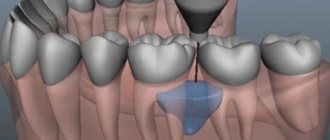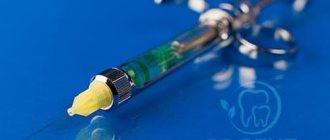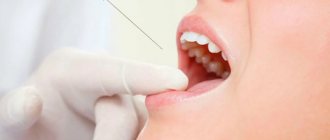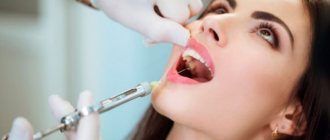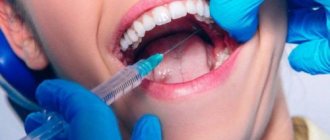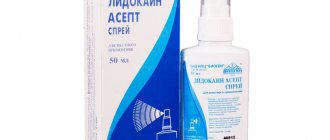It's no secret that most people avoid visiting the dentist simply because of the possible pain of the procedures. At the same time, the times when doctors performed complex manipulations without anesthesia are long gone, and today, any self-respecting dental clinic strives to solve the issue of pain relief at the most modern level.
As studies show, the pain threshold of all people is different and what one person is ready to endure will cause unbearable pain in another. Thanks to the developments of pharmaceutical companies, dentistry has become virtually painless. Today, anesthesia in dentistry already has a whole range of safe dental anesthetics. The type of anesthesia chosen by the dentist directly depends on the amount of dental treatment required, and any effect is painless.
Anesthesia in dentistry means relieving pain to the required minimum, and not to the point of blackout, since one of the important conditions for proper treatment is the doctor’s communication with the patient during treatment. The rationale is that pain relief is appropriate for the specific situation. After all, pain can provoke a state of shock in the human body. Consequently, patients’ fears regarding pain during medical procedures are not in vain. The harm caused to the body from pain has long been proven, but at the same time, pain relief itself can cause harm. Serious intervention in treatment and pain relief can cause more serious complications. Therefore, the dentist must be a specialist in anesthesia, competently use anesthesia methods, and be able to choose the right anesthetic that is both effective and safe.
Features of anesthesia in children in dentistry
In pediatric practice, pain relief plays a primary role. If an adult patient is able to endure mild discomfort and spend several hours in a row in a chair, then the child’s psyche is not yet ready for this. A painful procedure can instill a lifelong fear of dentists and interfere with quality treatment. Moreover, anesthesia gives the desired psychological effect and helps the child trust the doctor.
Features of pain relief in children
- Most drugs can only be used from the age of four, which imposes severe restrictions on the treatment of very young patients.
- The anesthesiologist must be highly qualified and be able to correctly calculate the dosage.
- The child may be afraid of treatment and dental instruments, especially needles.
- Children are often allergic to anesthetics.
Types of pain relief in children in dentistry
Local anesthesia
The most common method of pain relief in pediatric practice. Most often, it is carried out in two stages, combining a “freezing” gel or spray with an anesthetic injection.
General anesthesia
Sometimes it may be the only way to carry out treatment. They try not to use it without good reason, since the likelihood of complications after dental treatment under anesthesia is higher than after local anesthesia.
Sedation
This is an inhalation of a soothing mixture that allows the child to relax, but at the same time be conscious. Formally, sedation is not anesthesia, but it provides a slight analgesic effect and is often used in conjunction with an injection of an anesthetic.
Types of pain relief
The most common and popular of them are rightfully considered:
- local anesthesia,
- sedation,
- general anesthesia.
Local anesthesia
In pediatric dentistry, local anesthesia is used much less frequently than in the treatment of adults. This is explained by the fact that even an injection of an anesthetic into the gums can become a source of pain for the baby, enough for him to refuse to continue treatment calmly.
An alternative to the painful administration of anesthetics may be the use of special anesthetic gels (application anesthesia). Applying the drug to the gums not only does not cause discomfort to the little patient, but also helps him to easily tolerate most dental procedures.
Superficial sedation
In recent years, a method of pain relief for dental treatment in children, such as superficial sedation, has become increasingly popular.
Sedation methods
In modern dental practice, three methods are used to put the patient into a state of half-asleep:
- oral;
- intravenous;
- ZAX (oxygen).
Oral or oxygen sedation is most often used in pediatric dentistry. In the first case, the baby is offered to drink a pleasant-tasting cocktail containing safe sedatives. With Zaks, the child breathes oxygen oxide for several minutes through a special nasal mask.
A child in a state of sedation relaxes, demonstrates a willingness to sit quietly in a chair until the procedure is completed, and becomes more suggestible. At the same time, the child remains conscious, retains all reflexes and the ability to consciously communicate with the doctor and nearby parents.
Benefits of Sedation
The main advantages of using superficial sedation in dental treatment in children are:
- the ability to perform several dental procedures during one visit to the doctor;
- lack of emotional stress in the child (the baby practically does not see medical devices, does not hear the noise of the drill, does not smell the smell of medications);
- dulling of pain and tactile sensitivity;
- reducing the risk of complications or unwanted effects from the use of medications.
It should be noted that sedation does not eliminate the need for local anesthesia. This is due to the fact that sedatives have only a weak analgesic effect, and their action is aimed primarily at removing the emotional coloring of what is happening, dulling the feeling of anxiety and discomfort.
Contraindications for sedation
Unfortunately, sedation also has several contraindications. In particular, this method is not used in the treatment of children:
- under 3 years of age;
- those suffering from epilepsy;
- suffering from respiratory diseases.
In cases where the use of sedation is considered unjustified, treatment under general anesthesia may be recommended for the child.
General anesthesia
General anesthesia is a state of inhibition of the child’s central nervous system, accompanied by the disappearance of pain sensitivity, loss of consciousness and memory, relaxation of skeletal muscles, as well as weakening or switching off of reflexes.
Indications for the use of general anesthesia are:
- the need to carry out several large-scale dental procedures at once;
- detection of neurological or mental diseases in the baby (cerebral palsy, epilepsy, Down syndrome and others);
- lack of necessary contact between the doctor and the small patient;
- lack of the expected result from local anesthesia;
- allergy to drugs used for local anesthesia.
Modern drugs used to put children under anesthesia have a minimum of contraindications and undesirable effects, which makes dental treatment under general anesthesia not only effective and affordable, but also safe.
It is important to understand that pediatric dentistry is a field of medicine that requires doctors to have high professionalism, knowledge of psychology, the ability to get along with young patients and give them a positive attitude towards dental procedures. That is why, to undergo a course of treatment, it is advisable to contact only specialized children's clinics or medical centers that have special rooms for receiving children.
Local anesthesia in children in dentistry
Local anesthesia for dental treatment is used everywhere, since it provides the necessary analgesic effect, but at the same time maintains a certain sensitivity and has the fewest contraindications. Children, as a rule, tolerate it well.
Types of local anesthesia
The choice of one type or another depends on the procedure to be performed by the doctor, the age and psychological state of the child.
Application anesthesia
Local anesthesia in children in dentistry is not complete without the use of special anesthetic solutions or gels (most often based on lidocaine), which are used to treat the gums before starting treatment. The active substance easily passes through a thin layer of the mucous membrane and dulls sensitivity. As a rule, topical anesthesia is used to numb the site of the future injection - this is a typical feature of anesthesia in children in dentistry. But even one “freezing” with a gel or spray is enough for some procedures - for example, to remove mobile baby teeth, the roots of which have almost completely dissolved.
Topical anesthesia products in children's clinics have a pleasant taste and aroma to make it easier for the child to tolerate treatment.
Injection anesthesia
In pediatric practice, articaine-based anesthetics are most often used, which are administered using a syringe. This drug is approximately five times more powerful than novocaine, but is less toxic and less likely to cause allergies. It can be prescribed from the age of four.
Injection anesthesia has its own varieties. Pediatric dentists use infiltration or conduction anesthesia depending on the indications. In the first case, an injection is made into the mucous membrane at the border of the alveolar process and the transitional fold so that the anesthetic reaches the endings of the dental nerves. In the second case, the solution has an effect on the branches of the trigeminal nerve. Conductive anesthesia in children in dentistry is permissible from the age of six and is indicated for tooth extraction - mainly in the lower jaw.
Instruments for injection anesthesia
In children's clinics, they are gradually moving away from the use of classic syringes and ampoule solutions. They are replaced by more thoughtful and, importantly, psychologically comfortable solutions for the child.
- Needleless injector.
The anesthetic in such a device is supplied through a minimal (up to 0.1 millimeter) hole under very high pressure. The jet penetrates the surface of the mucous membrane or skin and enters the tissue. The analgesic effect with this principle of administration occurs faster, and a smaller volume of the drug is required. The absence of a needle in the injector is the key to a child’s good mood. - A carpule syringe
is a cartridge containing an anesthetic and, usually, a vasoconstrictor that helps prolong the pain-relieving effect of the solution. Unlike traditional ampoules, the carpule provides ideal sterility and more accurate dosage of all components. A special needle is placed on the cartridge: it is much thinner than the needle of a regular syringe and minimizes discomfort. - A computer syringe
is completely different from a regular syringe, so pain relief will be more comfortable for the child. The supply of solution in such a device is controlled electronically, and for the desired effect a smaller dosage of the drug is required. When the anesthetic is administered using a computer syringe, the child's face will not be as numb, so he will feel better during treatment.
Anesthesia without a needle
Here, of course, a lot depends on the upcoming procedures. However, topical anesthesia is an option that can and should be considered in cases where the needle of the anesthetic syringe causes the patient to pull the knees towards the chin and clench the jaw. Sometimes it makes sense to play on contrasts, that is, first mention the syringe as a mandatory element of the procedure, and then offer topical anesthesia as an alternative. As a result, you may end up with a much more compliant patient, not only with regard to pain management, but with treatment in general.
General anesthesia in pediatric dentistry
Sometimes in pediatric practice it is necessary to use general anesthesia. There must be serious reasons and indications for treating or removing teeth for children under anesthesia, because anesthesia is a deep depression of the nervous system, and this kind of exposure entails a risk of complications. A lot depends on the qualifications of the anesthesiologist: he must correctly calculate the dosage and take into account all the characteristics of the child’s body.
The anesthetic for general anesthesia is administered by inhalation. The child inhales the vapor of the substance and quickly falls asleep. This way, the doctor has the opportunity to carry out treatment in a calm environment, quickly and efficiently, while the little patient will not receive psychological trauma.
Indications for general anesthesia:
- A lot of work. It is difficult for a child to sit still, and if several teeth need to be treated in one session or a complex operation must be performed, then this mission becomes almost impossible.
- Allergy to drugs for local anesthesia. Articaine and other similar anesthetics may cause an allergic reaction. In this case, anesthesia may be the only solution.
- Ineffectiveness of local anesthesia. Sometimes the injection does not provide the required degree of pain relief due to the characteristics of the baby’s body. If the child remains highly sensitive, it is better to use anesthesia.
- Insurmountable fear of treatment. Severe dental phobia is an indication for general anesthesia if the child cannot be distracted from his worries with affectionate words, cartoons or toys.
- Some mental and neurological diseases (cerebral palsy, epilepsy, Down syndrome and the like).
What to do if your child has allergies?
Allergy to anesthesia in dentistry in children is a fairly common occurrence. The child's body is more susceptible to unusual reactions to new substances, which include anesthetics. Before visiting the dentist, it is necessary to undergo tests to understand whether local anesthesia is acceptable, and if an allergic reaction does occur, treatment is carried out under anesthesia.
What are the dangers of local anesthesia?
Dental treatment and prosthetics under general anesthesia often becomes the source of many questions. Is it dangerous to use anesthesia in this way? Will this affect your health? Are fillings on several teeth worth artificially induced sleep? After all, each of us has heard that any general anesthesia is not without consequences for the human body. Moreover, local anesthesia seems to have been successfully used for dental treatment for a long time. Of course, we are horrified by the forced “heroism” of the Soviet people, who treated their teeth without any pain relief at all - with the exception of removal, when a drug was used that did not always act properly. People of that era, not only general anesthesia, even local anesthesia could be considered a luxury. This, by the way, explains the “genetic” fear of the dentist even among the children of those who lived in those days.
However, now, as it seems to us, there are practically no problems - any pharmacy chain in Moscow will offer local anesthetic drugs to choose from. It will be enough just to give an injection and the doctor will effectively treat your teeth without any pain. Isn't this enough? Why use general anesthesia for dental treatment? Many people believe that local anesthesia is much less harmless than general anesthesia. However, is the notorious “freezing” so harmless and does it really have no effect on our body?
However, local anesthesia only looks harmless. In fact, novocaine is combined with the hormone adrenaline to narrow the capillaries, which provides a long-lasting anesthesia effect. Adrenaline, in turn, causes an increase in heart rate, which is quite undesirable for those who suffer from cardiac problems. Both novocaine and other drugs that are its analogues can cause allergies. Also, local anesthesia can increase blood pressure or cause vasospasm. Of course, if the patient’s heart is fine, as well as his blood pressure, local anesthesia does not threaten such a person. However, where can one find an absolutely healthy person in the current ecology?
If you have a problem similar to that described in this article, be sure to contact our specialists. Don't diagnose yourself!
Why you should call us now:
- We will answer all your questions in 3 minutes
- Free consultation
- The average work experience of doctors is 12 years
- Convenient location of clinics
Single contact phone number: +7
Make an appointment
If the patient has problems with the heart and blood pressure, then local anesthesia is simply contraindicated. And any conscientious dentist, before using local anesthesia, will definitely ask the patient about his state of health. And, most likely, having heard complaints about hypertension or heart problems, he will recommend general anesthesia instead of “freezing,” which will cause much less harm to the body.
Alternative to general anesthesia
Sedation is considered a safer alternative to general anesthesia. This procedure involves inhaling a special mixture of nitrous oxide and oxygen through a mask. It makes the child feel relaxed and slightly drowsy, lifts his spirits and calms him down. At the same time, the small patient remains conscious and can interact with the dentist.
Sedation is not anesthesia, but has a slight analgesic effect. It is usually combined with an anesthetic injection. The mixture of gases is supplied through a special device that controls the duration and dosage and allows you to smoothly enter and exit the state of sedation. The effect of the procedure wears off within about 10 minutes after stopping the supply of nitrous oxide.
